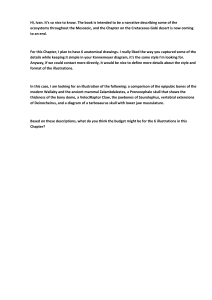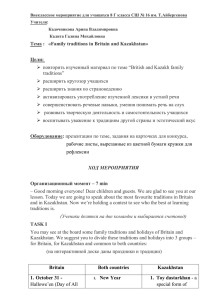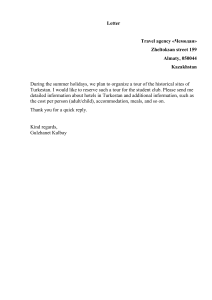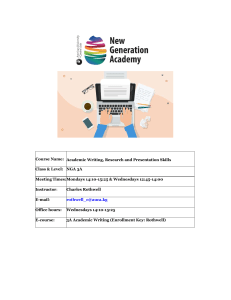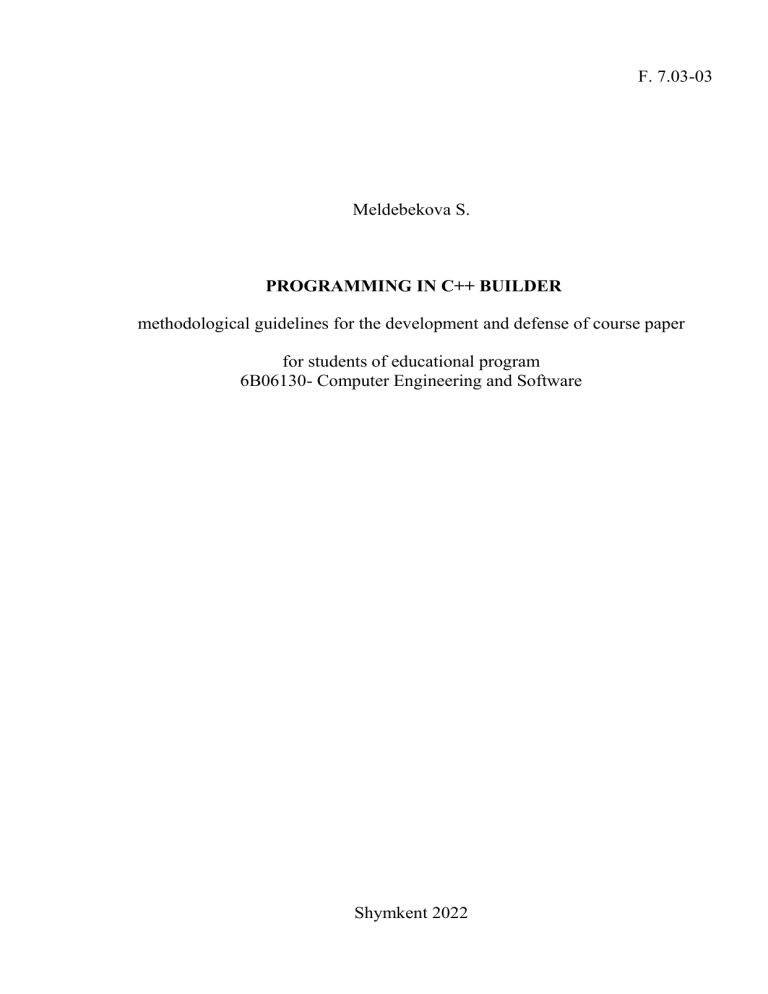
F. 7.03-03 Meldebekova S. PROGRAMMING IN С++ BUILDER methodological guidelines for the development and defense of course paper for students of educational program 6В06130- Computer Engineering and Software Shymkent 2022 2 MINISTRY OF SCIENCES AND HIGHER EDUCATION OF THE REPUBLIC OF KAZAKHSTAN Non-profit joint stock company «M. Auezov South Kazakhstan university» Chair «Computer Engineering and Software» Meldebekova S. PROGRAMMING IN С++ BUILDER methodological guidelines for the development and defense of course paper for students of educational program 6В06130- Computer Engineering and Software Form of study: full-time SHYMKENT 2022 3 Compiled by: Meldebekova S. «Programming in C++ Builder». Methodological guidelines for the development and defense of course paper. Shymkent: Non-profit joint stock company «M. Auezov South Kazakhstan university», 2022. - 29p. Methodological guidelines are compiled in accordance with the requirements of the curriculum and working training program of discipline "Programming in C++ Builder" and include all the necessary information on the course paper writing. Methodological guidelines are intended for students of educational program 6В06130- Computer Engineering and Software Methodological guidelines are intended for the preparation, implementation and design of course paper, performed by students in accordance with the curriculum. Provided the necessary teaching material for the course paper implementation, that helps students for determine the content, the order of implementation and the requirements for developed software product design. Reviewers: L.Musabekova - D.sc., professor Reviewed and recommended to the press meeting of the chair "Computer Engineeringand software"(Minutes №___,"____"____2022) and the Committee on "Innovative technologies of training and methodological provision High School "Information technology and energetics"(Minutes №__,"__"___2022). Recommended for publication by the Training Council of M.Auezov SKU , Minutes № __"___"___2022 © M. Auezov South Kazakhstan State University, 2020 Responsible for release Meldebekova S.K. 4 CONTENT Introduction ………………………………………………………………. 1 The order of the course paper organization ............................................ 1.1 Requirements for the course paper thems ……………………………. 1.2 Requirements for the order of the course paper writing ...…………… 2 Content and structure of the course paper …………………………… 3 Rules for the design of the course paper ……………………………….. 3.1 Design of the text part ……………………………………………….. 3.2 Design of the graphic part ……………………………………………. 3.3 Formulas and equations ……………………………………………… 4 Protection of course paper …………………………………………….. 4.1 The order of presentation of course paper for the protection………… 4.2 The order of protection of the course paper........................................... 4.3 Evaluation of course paper ................................................................... 4.4 Typical errors ………………………………………………………… 5 The approximate structure of the student's report… .. …………………. 6 Assignments for course paper ………………………………………….. Recommended literature ............................................................................ The criterion for assessing the knowledge of students .............................. Appendix A. Title page of course paper ..................................................... Appendix B. Form of assignment for course paper ................................... Appendix C. Form of information on the course paper protection ............. Appendix D. Protocol for course paper protection ..................................... 5 6 7 7 7 9 13 13 14 17 16 17 17 17 18 20 21 22 23 24 25 26 27 INTRODUCTION Writing course paper is an independent development of a specific topic of a small volume with elements of scientific analysis, reflecting the theoretical knowledge and practical skills acquired by the student, the ability to work with literature, analyze sources, and draw detailed and well-founded conclusions. Course paper reveals a scientific problem based on the student's independent research. Course paper is aimed to demonstrate the student’s abilities and research skills as well as his/her theoretical knowledge, appropriate to the level of the course, in identifying and solving problems. The course paper will comply with the following requirements: - it will be an independent research on a topical issue; - it will contain accurate, clear and logical presentation of the progress of the research and its results, as well as conclusions and suggestions the author has arrived to; - it will demonstrate the students grasp of using and evaluating specialized literature and other sources, gathering and processing information, as well as applying research methods and computer technologies. The main purpose of the course paper is to create a program, representing the first software product, information system program using a database or development of the game program. The student is tasked with developing a software product in order to solve a specific problem. The result of the decision is: executable file of the program; explanatory note, drawn up taking into account the requirements of standards. To solve the problem, the student must first familiarize himself with the literature on the topic of the assignment. In this case, they you should pay attention to the means used to solve similar problems or to solve any key points of the problem. Course paper should cover the main stages of software product development from setting the problem to software implementation of the application, its compilation, testing and documentation. Course paper allows you to expand the volume of students' knowledge in the studied area and create a real basis for using their knowledge to solve problems on a computer in all other disciplines in their further practical activities. 6 1 The order of the course paper organization 1.1 Requirements for the course paper thems To complete the course paper, the student receives an individual task from the teacher - for the title of the topic of the course paper, which indicates the software product being developed . The topic of the course paper can be selected from the list of topics given in the section «Assignments for course paper». The topic can be suggested by the teacher. The topic of work can be offered to students independently. In any case, it is necessary to approve the selected topic and receive an assignment for a course paper. 1.2 Requirements for the order of the course paper writing The main stages of the course paper are: 1 . Drawing up a plan for course paper . After choosing a topic, the student, together with the leader, draws up a schedule for the course paper . The goals and objectives of the course paper are formulated. 2 . The study of recommended and additional scientific literature , familiarization with normative documents and other sources, is carried out by the student independently in the library. 3. The choice of means of implementing the course paper When implementing the course paper, you must choose an environment for writing program code and, if necessary, tools for creating a database . It is assumed that the development of program code, testing, debugging, compilation of the application can be performed in any programming environment and using any programming language at the request of the student . Database creation can also be performed using visual tools Microsoft Visual Studio .NET , Microsoft ACCESS , tools provided in Micro soft SQL Server, etc. 4 . The development of the application code is carried out in accordance with the stages of the software life cycle. When developing a user application, it is necessary to interact with the work supervisor , attend consultations in accordance with the schedule, take the initiative for additional contacts with the supervisor (e-mail, attendance at general consultations of the teacher). To complete the coursework, the student must develop : applied program on the instructions of the head of the course paper ; the use of two basic classes of information systems: information retrieval B with threads and data processing systems; apply modern programming languages; provide for the use of the latest technologies in computing; 7 Stages of creating a software application A typical life cycle of a software product of any class is a sequence of stages: Problem statement and analysis of the subject area; System design; Programming modules; Testing and debugging; Implementation, adaptation and maintenance of a software product. Each stage of the life cycle is characterized by a number of works performed within this stage. 1. The stage of setting the problem and analyzing the subject area includes: Formulation of requirements for the functionality of the future software product; Determination of the volume and structure of data stored and processed in the system; Determination of the main tasks that need to be implemented in the program code; Assessment of the required reliability of the software system, etc. 2. In the design phase provided the execution of such works as: Identification I described domain objects; Decomposition I features a software system; Develop a model structure developed imaging software modules. 3. At the stage of programming system modules, the following is performed: Writing program code of individual modules; Compilation of the project. 4. The stages of testing and debugging include, including: Test development for multifunctional testing and debugging; Pairing with real equipment; 5. Under the implementation, customization and support of the software to understand: Release of documentation on the software system; Installation of a software product; Generalization of operating experience; System administration. The basis of the software product, developed as part of the course paper is a software product , providing s user experience in beats obnom for his form. The application must present a distribution package that can be installed on the user's computer. 8 2 Content and structure of the course paper The course paper should be written in good scientific language, i.e. in compliance with the general norms of the literary language, the rules of grammar and taking into account the peculiarities of scientific speech - the accuracy and unambiguity of terminology and style. An explanatory note of the course project (work) should contain the following structural elements: Title page (Appendix A ). For course paper assignment (Appendix B ) Coursework protection protocol (Appendix D ) Content Introduction The main part Conclusion List of used literature Application Before the final printing of the finished document, it is necessary to submit the explanatory note to the manager for verification. Each structural part of the course paper has its own purpose. The content. The content of the course paper includes normative references, definitions, designations and abbreviations, an introduction, serial numbers and titles of sections, subsections, a conclusion, a list of references and names of applications indicating the page numbers from which these elements of the course paper begin. The content does not include the title page, individual assignment and annotation. Collect content in automated Word. Introduction. The introduction should contain: Relevance of the research topic Scientific novelty The purpose and objectives of the course paper Objects and research methods Practical importance. The volume and structures of the course paper . The introduction should not contain requirements. The introduction is not numbered and is placed on a separate sheet. It is necessary to note an important rule - the introduction, like the conclusion, is recommended to be written after the full completion of the main part. It is not recommended to make an introduction more than 1.5-2 pages long. Main part The title "main part" is not written in the work. Typically, the main body consists of several chapters and sections within chapters . The chapters should be commensurate with each other, both in terms of structural division and in 9 volume. The content of the sections can be illustrated with explanatory examples, tables, diagrams. Individual sections can be combined. Recommended structure for the main body. 1 Goals and objectives of the developed software product 1.1 Purpose and scope 1.2 Problem statement 1.3 Algorithm Description 1.4 Selection of the composition of hardware and software 2 Software product development 2. 1 Development Program 2.2 Description of the program (or its modules) 2. 3 Introduction Purpose and scope. The purpose of the program and a brief description of the scope of the program are indicated here. Formulation of the problem. The solution of the problem begins with its formulation , which reveals the content of the problem and determines the final goal. At this stage, all physical quantities involved in the task must be given mathematical notation. It is most convenient to use generally accepted designations (h - height, l - length, s - area, etc.), but it is allowed to designate all quantities arbitrarily. Then we define the "status" of each variable, i.e. determined yaem , which of the following categories it belongs: initial data - these values are known from the problem statement; result - these values need to be found; intermediate data - these values are not known in advance, but are determined in the course of solving the problem in order to find the result. The result (output information) can be presented in the form of documents, frames on the monitor screen, information in the database. The following actions at this stage - you need to describe the restrictions on quantities and their relationships in the form of inequalities, formulas and equations on seemed necessary capacity and precision of values, and to determine the conditions of the algorithm is complete. The description of the values can be displayed in the table ( see table 1) . Table 1 - Description of variables Value Designation Data type initial scale integer fam string [20] s real result distance real Limitations The size Description scale> = 0 2 bytes map scale 20 characters surname s> = 0 6 bytes distance on the map 6 bytes real distance 10 The following describes the possible ways of solving the problem , programming techniques, you can decree be their advantages and and disadvantages , and . A method for solving the problem is selected and justified. For example , if the task uses dynamic structures, then the types of dynamic data structures and the basic procedures for working with dynamic structures are listed. If the task is to form a database and further work with the database, then a description of the data types used (characteristic of data of a written type) and techniques for working with files are given. Description of the algorithm. The section provides a generalized verbal description of the algorithm for solving the problem, outlines the main requirements for the algorithm and the ways of their implementation. The scheme of the algorithm of enlarged modules is given. Further, each module is detailed. Enlarged teams are allocated, which are implemented using auxiliary algorithms. Then the auxiliary algorithms are detailed. In total in this section it is necessary to give at least three schemes of algorithms. The development of an algorithm for solving any problem is the most crucial and important moment, since it is the algorithm that determines the sequence of actions performed by the computer. Therefore, the main goal in solving the problem is to build a good algorithm. Selection of the composition of hardware and software . On the basis of the developed algorithm, it is concluded that it is necessary to use one or another programming language. The advantages of the chosen programming environment are listed. The technical means necessary for the optimal operation of the running program are determined. In this regard, it should be remembered that the assignment for the course paper is formulated as developing an application for Windows . Software product development Program development . Modern programs are designed to function in the Windows environment. Students develop a Windows application in a visual programming environment. Visual programming is based on the close interaction of two processes: the process of constructing a Windows window; the process of writing code that gives the elements of this window and the program as a whole the necessary functionality. Description of the program (or its modules) . This section provides the exact name of the program and its composition , i.e. the number of modules and their purpose . It is necessary to show the connection between the modules in the form of a diagram. Display the program composition in the form of a table (see Table 2) . 11 Table 2 - Composition of program project Name Appointment Note Pr_ Project file Links all the files that make up the Progress.dpr application Person.Db Database file Contains information about employees Implementation. In this section covers: conditions for the execution of the program; instructions for the user; messages to the operator. In the "Condition of program execution" should be specified conditions required for executing the program (the minimum and / or maximum composition of hardware and software, etc.), must be listed a method call to a program corresponding to the storage medium, the entry points in the program. In the "Instructions for the user " section, the sequence of operator actions must be specified to ensure loading, starting, executing and terminating the program. The section provides information for testing, ensuring the functioning and customizing the program for a specific application. The order and sequence of entering the initial data and obtaining the calculation results are listed. The section "Messages to the operator" should contain the texts of messages displayed during the program execution, a description of their content and the corresponding actions of the operator. Conclusion. The conclusion contains a short formulation of the results obtained in the course of the work. In conclusion, as a rule, the author summarizes the results of understanding the topic, conclusions, generalizations and recommendations that follow from his work, emphasizes their practical significance, and also determines the main directions for further research in this area of knowledge. It must be borne in mind that the introduction and conclusion are never divided into parts. The volume of confinement should be approximately equal to the volume of administration. List of used literature. List of sources and literature (books, papers, internet resources) used in the development of course paper, a mandatory attribute of any scientific - research work, including foreign exchange. The list of used literature includes all sources in the order of references in the text of the explanatory note. Bibliographic description is given (place , publisher , publication date, etc .) Each of the sources in accordance with the SCES 7.1-2003. The bibliographic list must have at least 12 - 15 titles. 2-3 sources in English. Applications. Applications are a required component of coursework. Applications can be different: tables, diagrams, graphs, illustrations, program codes , etc. 12 Applications are not counted in the specified amount of course paper. In the text of the course paper, all applications should be referenced. Applications are arranged in the order of links to them in the text . Each application starts with a new sheet. Applications are designated in capital letters of the alphabet, starting with A. The word "Application" is followed by a letter indicating its sequence. Applications should have a sequential pagination in common with the rest of the course paper . 3 Rules for the design of the course paper The stage of design of the course paper is no less important than the others, at this stage the author must bring all the materials on the course paper into a single document and draw up in accordance with the requirements. The decorated work must be bound. The design of the final version of the course paper is started after taking into account the remarks of the head, making their own additions and changes. 3.1 Design of the text part Course paper is drawn up in accordance with the Interstate Standards: SCES 7.32-2001 “Report on research work. Structure and design rules ", SCES 7.1-2003" Bibliographic record. Bibliographic Description ". The presentation of the explanatory note of the course paper should be short, clear. Generally accepted abbreviations are allowed in the text. Initial data, digital materials, solution results must be summarized in tables, the form of which is either given or developed by the student. Errata, clerical errors and image detected in the preparation of course paper is allowed to correct the erasure or painting and application of white paint on the same location of the corrected tech hundred typewritten, or handwritten way (black ink or black ink). Surnames, names of institutions, organizations, firms, product names and other proper names in the course paper are given in the original language. It is allowed to use computer capabilities to focus on certain terms, formulas, using fonts of different typefaces. The volume of course paper (without appendix) ranges from 25 to 35 pages of computer text . Fonts, indents, margins. Course paper is performed on standard A4 sheets. The text is written on one side of a sheet with margins: left margin - 30 mm ; right - 10 mm ; bottom - 25 mm , top - 20 mm . The text is printed at 1.0 spacing. Font TimesNewRoman , p Dimensions 14. The first line indention 1.25 cm . Headings. Each structural part of the course paper begins on a new page. The distance between the chapter and the text following it is 1 space . The distance between the text and the following paragraph 2 spacing. 13 The names of chapters and paragraphs should be printed with paragraph indentation, with a capital letter without a period at the end, without underlining. If the name consists of two sentences, they are separated by a period. Hyphenation in heading words is not allowed. Numbering. Pages are numbered in ascending order. Page numbers are placed at the bottom of the page from the center. The title page, a task for course paper, annotation, content, definition, normative references, symbols and abbreviations, included in the total numbering, but the number of pages they are not listed. The first printed page number will be on the second sheet of the introduction if the introduction consists of more than one page . References and footnotes. References to the literature used are obligatory, since this is the manifestation of the culture of attitudes towards someone else's thought, someone else's text. References in the text are given in the form of a number corresponding to a literary source or a normative document given in the bibliographic list and enclosed in square brackets. When designing footnotes, they are placed on the same page under the lines of the main text, separated from it by a small horizontal line. 3.2 Design of the graphic part Decoration of illustrations Illustrations (drawings, maps, graphs, charts of algorithms, diagrams, photographs) placed immediately after the text in which they are mentioned for the first time, or on the next page . Numbering. Illustrations, with the exception of illustrations of the appendixes, should be numbered in Arabic numerals with continuous numbering: Figure 1. It is allowed to number illustrations within the section. In this case, the illustration number consists of the section number and the sequence number of the illustration and , separated by a period. For example: Figure 1.1. The illustrations, if necessary, can have explanatory data (picture text). The figure text is written in size 12 font. The word "Picture" and its name are placed after the explanatory data. The figure and its name are placed in the middle of the line. 14 Figure 1. Intended type of main content All illustrations should be referenced in the course paper. When referring to illustrations, one should write "... in accordance with Figure 2" with continuous numbering and " Figure 1.2 shows ... " with numbering within the section. Building tables Tables are used for better clarity and ease of comparison of indicators. The name of the table should reflect its content, be precise and concise. The table title should be placed above the table with paragraph indention . Tables, with the exception of annex tables, should be numbered with Arabic numerals or sequentially numbered within a section. In this case, the table number consists of the section number and the table number, separated by a dot. For example: "Table 3.1". It is allowed to use a font size smaller in the table than in the text. The table should be placed immediately after the text in which it is mentioned for the first time, or on the next page. All tables should be referenced in the work. Example of table design To solve the problem, we need the initial and final values (variables). The type and designation of these quantities is given in table 3 . Table 3 - Description of variables Value initial result Designation k s Data type integer real 15 Description Loop parameter P Performan summation A table with a large number of lines can be transferred to another sheet (page). When transferring a part of the table, the word "Table" and its number are indicated once above the first part of the table, the word "Continuation" is written above other parts and the number of the table is indicated, for example: "Continuation of table 1". When transferring part of the table, the lower horizontal line limiting the table is not drawn. It is advisable to put a table with a large number of graphs in the application. 3.3 Formulas and equations Formulas and equations should be separated from the text on a separate line. Above and below each formula or equation must be left at least one free line. If the equation does not fit on one line, then it must be wrapped after the equal sign (=) or after the plus (+), minus (-) signs, multiplication (x), division (:), or other mathematical signs, and the sign in the beginning of the next line is repeated. An explanation of the meanings of symbols and numerical coefficients should be given directly under the formula in the same sequence in which they are given in the formula. Formulas in a course paper should be numbered with ordinal numbering throughout the entire work in Arabic numerals in parentheses in the extreme right position on one line. Example: A = a: b (1) B = c + d (2) References in the text to ordinal numbers of formulas are given in parentheses. An example is in formula (1). Numbering of formulas within the section is allowed. In this case, the formula number consists of the section number and the serial number of the formula, separated by a dot, for example (3.1). 16 4 Protection of course paper 4.1 The order of presentation of course paper for the protection At this stage, it is necessary to think over and discuss with the work manager the materials submitted for protection (slides, if used, database, application program code, prepared explanatory note). Draw up a speech plan, discuss it with the work manager. Having received the course paper after being checked by the supervisor, the student must arrange it in accordance with the requirements, eliminate logical and stylistic errors, typos, re-stitch (sew), prepare an electronic presentation (in agreement with the supervisor). Then it is necessary to sign the coursework standard control. A week before the protection of the course paper, you must check your work for anti-plagiarism with the person in charge of checking for anti-plagiarism of the department and get a certificate from him about the passage of the course paper for anti-plagiarism 4.2 The order of protection of the course paper The protection of the work must take place within the timeframes specified in the assignment for the course paper in accordance with the protection schedule . The protection of the course paper is carried out publicly in the presence of students with the participation of the head and members of the commission. One of the members of the commission is a representative of Department on the academic questions, who controls the procedure for protection course papers and fills in information on protection course papers. On the protection of the course paper, the student must briefly outline the main content of the work, focusing on independently drawn conclusions, completed stages of development. The duration of protection coursework second operation consists of one student's report of 8 to 10 minutes and answer questions. No more than 20 minutes in total. 4.3 Evaluation of course paper Courses work is estimated differentiated assessment. In accordance with the modular-rating system of training and the schedule for the implementation and delivery of tasks. On monitoring implementation of student first job is given a maximum of 60 points and final control (protection) a maximum of 40 points. At the end of the protection of the course paper, a protocol is drawn up (Appendix 3 ) and the student is given a grade on the same day. Courses works and is due and be protected prior to the examination session and serves as admission to the examination in the discipline. A student who has not 17 submitted in a timely courses work or will not protect its valid reason, is considered to have academic debts. Coursework evaluation criteria : he degree of assimilation by the student of concepts and categories on the topic of course research; Ability to work with documentary and literary sources; Ability to formulate the main conclusions based on the results of the analysis of a specific material; Literacy and style of presentation; Independence of work, originality in understanding the material; Correctness and relevance of the design; Compliance with the design of the course paper to the established requirements. Criteria, in the presence of at least one of which, the work is assessed only as "unsatisfactory": The topic or content of the work is not related to the subject of the discipline; hework is reprinted from the Internet, CD - ROM or other media; Unstructured coursework plan; The volume of work is less than 20 sheets of computer text; The appendix is missing; The design of the course paper does not meet the requirements (lack of numbering, incorrect design of the bibliography, etc.) 4.4 Typical errors The following typical mistakes made by students in the explanatory note can be noted : 1. The course paper is written in the first person. 2. The author (student) asks questions in the course paper. 3. There are more than three chapters in the work, most of which contain theory. 4. The theoretical section of the course paper does not contain references to the literature used. 5. The actual (digital) material used in the course paper is outdated. 6. The analytical section of the course paper does not contain graphic materials (tables, figures). All tables and figures are included in the appendix. 8. Tables, figures, list of used literature, titles of chapters and sections are not drawn up in accordance with GOST, requirements for font size , paragraph indentation and line spacing are not observed . 9. Points of course paper begin and / or end with a table, figure, formula, number. In addition, the teacher draws attention to the following common mistakes in students' work: 18 1. Lack of clarity in defining the main content of the course paper, convincing evidence, rationale, conclusions and recommendations; 2. Violation of the sequence of presentation, frequent repetitions, unclear wording, reservations, grammatical errors; 3. The examples presented in the text are not supported by the semantic content, the author's thoughts; 4. Course paper is a retelling of literary sources, a set of quotes, phrases. No program code or its fragments available in the teaching materials for the course is not accepted as "own" development in the course project. A student who does not fulfill this requirement is removed from the protection of the project. 19 5 The approximate structure of the student's report The student's report during the protection of the course paper must contain the following information: 1. Topic, goals and objectives of the course paper. 2. Technical characteristics of the program design: formalization of requirements, algorithms for solving the problem, justification of the selected software tools. 3. Implementation of the program: The developed forms of the program with a description of the components, the composition of the program, the composition and structure of the database , the scheme of linking tables , messages to the operator . 4. User application is due to be shown on the right on your computer. 5. Application code with comments. 6 Conclusions on course paper. The positions of the project submitted for protection are: Analysis of the task, formalization of requirements, selection of software for project implementation. User application program code. Application interface (design, functionality of controls, visibility and adequacy of the interface). Database for testing the application. Documenting the design and programming steps in an explanatory note. 20 6 Assignments for course paper Students choose any of the proposed topics or can suggest their own topic. The main condition for the choice is the absence of repetition of topics in the student group. 6.1 Development of a software product on the following topics 1. Development an application for managing the database of students passing the examination session (exam name, exam date, teacher's name, number of grades, grades). 2. Development a student hostel database management application. 3. Development an application for managing the database of coursework issued to students. 4. Development an application for managing a database of student attendance. 5. Development an application for managing the student library database (full name, library card number, book title, return date). 6. Development a student accounting database management application. 7. Development an application for managing the database of distribution of vouchers of the student trade union committee. 8. Development an application for managing a database containing a schedule of student classes. 9. Development an application for managing a database of utility bills for an apartment. 10. Development an application for managing the Internet access time tracking database. 11. Development an application for managing the database for recording the time of telephone conversations. 12. Development an application for managing the database of insurance policies. 13. Development an application for managing a database of customer records for a company offering computer services. 14. Development an application for managing the database of bank customers (full name, account number, account amount, date of last change). 15. Development a flight database management application (flight number, destination, ticket time, departure date, ticket price). 16. Development an application for managing the database of a doctor's guide (disease database: name, symptoms, procedures, list of recommended medicines indicating the required amount). Formation of a prescription after examining the patient. In the application being developed, add, edit and delete records from the database, save the results in a file (create a text report). 21 Recommended literature Main: 1. 2. 3. 4. 5. 6. R.Lafore. Object-Oriented Programming in C++. Fouth Edition by Sams Publishing. USA. 2012. 1038p. Andrew Koenig, Barbara E. Moo.Accelerated C++: Practical Programming by Example, 2015. Nicolai M. Josuttis.The C++ Standard Library - A Tutorial and Reference, 2nd Edition, 2012. Zoo Jacques E. Borland C++ Builder Programming. Function X Practical Learning Series. 2013. -820p. Bruegge В. Object-Oriented Software Engineering: Conquering Complex and Changing Systems. -New Jersey: Prentice Hall, 2015. -553 p. Fedorov, D.Yu. Programming in high-level language Python: a textbook for applied bachelor's degree / D. Yu. Fedorov. - M.: Yurayt, 2018 .-- 126 p. Additional: 7. Developer’s Guide. Borland Software Corporation 100 Enterprise Way, Scotts Valley, CA 95066-3249, 2002, 1284 p. 8. Schildt H., Guntle G.L. Borland C++ Builder. The Complete Reference McGraw-Hill Publishing Company Limited, 2001. — 977 p. 9. Swart B., Cashman M., Gustavson P. Borland C++ Builder 6 SAMS, 2002. - 1128 p. 10.Programmirovanie algoritmov v srede Builder C++: Laboratorny`j praktikum po kursam «Programmirovanie» i «Osnovy` algoritmizaczii i programmirovanie» dlya stud. 1–2-go kursov vsekh specz. BGUIR dnevnoj i vechernej form obuch: A.K. Siniczy`n, A.A. Navroczkij, A.V. Shherbakov i dr. ; Pod obshh. red. A.K. Siniczy`na. – Mn.: BGUIR, 2004. – 92 p. Multimedia support 1. The C++ Language Tutorial. cplusplus.com, 2008. 2. Learn C++ programming language. https://store.tutorialspoint.com 22 Criterion for assessing the knowledge of students Letter Grade А АВ+ В ВС+ С СD+ D Points in numbers 4,0 3,67 3,33 3,0 2,67 2,33 2,0 1,67 1,33 1,0 %-percentage FX 0,5 25-49 F 0 0-24 95-100 90-94 85-89 80-84 75-79 70-74 65-69 60-64 55-59 50-54 23 Assessment in traditional system Excellent Good Satisfactory Unsatisfactory APPENDIX A Title page of course paper F.7.04-02 MINISTRY OF SCIENCES AND HIGHER EDUCATION OF THE REPUBLIC OF KAZAKHSTAN Non-profit joint stock company «M. Auezov South Kazakhstan university» Higher School of Information Technology and Energy Chair «Computer Engineering and Software» EXPLANATORY NOTE to course paper topic: ___________________________________________ on the discipline «Programming in C++Builder» educational program 6В06130- Computer Engineering and Software Work is protected with assessment ____________ (assessment, date) performed by______________________ (student’s name and surname) group___________ «_____» ______________ academic supervisor Meldebekova S.______ (signature) Norm control _________________ (name and surname,signature) Commission _________________ (name and surname,signature) _________________ (name and surname,signature) Shymkent, 2022 24 APPENDIX B Form of task for course paper F.7.04-03 MINISTRY OF SCIENCES AND HIGHER EDUCATION OF THE REPUBLIC OF KAZAKHSTAN Non-profit joint stock company «M. Auezov South Kazakhstan university» Chair «Computer Engineering and Software» «APPROVED» Head of the department ___________ Akhmetova S.T. (signature) "______" __________ 2022year Task № ____ for the implementation of course paper (project) in the discipline «Programming in C++Builder» Student (s) _________________________________ group _________________ Topic of work (project) _______________________________________________ __________________________________________________________________ Initial data:__________________________________________________ __________________________________________________________________ No. Coursework content / project explanatory note content Approximate Timing number of pages realization by section 1 No. Content of the graphic part Timing realization Number of sheets Format 1 Recommended literature: 1________________________________________________________________ 2________________________________________________________________ 3________________________________________________________________ Date of issue of the task _______________________________________________ Date of protection of the work _______________________________________ Academic supervisor of the work _______________________________________ The task was accepted for execution ___________________________________________________ (signature) 25 APPENDIX C Form information about protection of the course paper F. 7.04-05 Non-profit joint stock company «M. Auezov South Kazakhstan university» High school ____________________________________________________ Department ______________________________________________________ Discipline ______________________________________________________ Number of students _____________________________________________ PROTOCOL No. Group Name of student Assessment date Director Representative of DAQ ____________________________ Head of the Department _____________________________ 26 Note APPENDIX D Coursework protection protocol F.7.04-06 MINISTRY OF SCIENCES AND HIGHER EDUCATION OF THE REPUBLIC OF KAZAKHSTAN Non-profit joint stock company «M. Auezov South Kazakhstan university» Higher School " Information Technology and Energy " Chair «Computer Engineering and Software» "APPROVED" Head of the department "CEaS" Akhmetova S.T. _________________________ "____" _____________ 20__ PROTOCOL No. ____ Defense of course paper discipline "______________________________________________________" Student _________________________________ group ___________________ Course paper topic : ________________________________________ __________________________________________________________________ When protection is, replies had been received on the following questions: 1.________________________________________________________________ 2 .________________________________________________________________ 3 .________________________________________________________________ When the course paper prepared Score (out of 60 possible) ___________, protection is evaluated (of the 40) in __________ scores. Total scores _______________. Assessment of work ___________________________. Coursework director _________________________ Commissioner ___________________________________ Commissioner ___________________________________ Protection date __________________ 20__ 27 Meldebekova Saule Korgambayevna PROGRAMMING IN С++ BUILDER methodological guidelines for the development and defense of course paper Signed print _ __ _.____. 2022 Paper size X x Y 1/16 Typographic paper. Offset printing. Volume 2 pp. Circulation 50 copies. Order No. _____ © The publication of the M.Auezov South Kazakhstan University Publishing Center M.Auezov SKU, Shymkent, Tauke khan ave., 5 28
